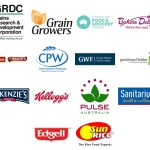
Long term readers of this blog (anyone who’s been reading it for a month) will know what I think of the concept of exercising to lose weight. A can of coke contains enough energy to power you riding a bike for 8km. So why not skip the coke and the 8km ride and call it a day?

In Sweet Poison I pointed out that multiple studies have shown that in addition to all the other good things that fructose does for us, it also increases our appetite.

The Riverbend public lecture was a sellout! Thanks very much to all who attended. I loved meeting you all and hearing your stories.
If you’ve been anywhere near a naturopath or a health food store in the last five years, you will have probably come across the message that fructans are good for you. A few people have asked me how or if they are related to fructose and what I think of them.
In a nutshell, the answer is that (like most things) I am happy to eat fructans au naturelle (in the original vegetables that contain them), but I don’t want them added to everything else just to get a ‘healthy’ looking label. I will be avoiding things that have fructans added and here is why.
Plants convert sunlight to energy by creating sugars. The two primary sugar molecules are fructose and glucose. To store this energy, plants join these simple sugars together in long chains. Chains which are mostly glucose are called glucans.
Cellulose, the hard stringy indigestible bits of plants we usually call fibre is a glucan. Starch is another important glucan which we encounter most in our daily diet. It forms the foundation for most of the carbohydrates, we eat. Animals (like us) also store energy as glucans. When we have too much glucose in our blood, we create glycogen (a glucan) and store it around our livers as a short term supply of glucose (to get us through between antelope kills).
Chains which are mostly fructose are called fructans. Nobody knows why some plants store their sugar as fructans and others as glucans but researchers speculate that given the types of plants that do it, it might have something to do with drought tolerance. Fructans are most common in Onions and other tubers like Chicory but they are also in Barley, Wheat, Artichokes and Asparagus. They are present to some degree in about 15% of plants.
Fructans are less well known, but one that you might have seen popping up on the ingredients list of some foods is Inulin (yes, inulin NOT insulin). Inulin is a chain of about 60 fructose molecules and one glucose molecule.
Humans (and most other mammals) do not have the enzymes (chopping shears) necessary to cut up a fructan like inulin. We do have enzymes for sugar, fructose, glucose and starch, so when we eat those sugars, they get dealt with immediately in our small intestine (with disastrous consequences in the case of fructose).
But when we eat inulin it sails straight through our small intestine and becomes pet-food for the bacteria that inhabit our large intestine. Our little passengers love the stuff, chomping away furiously on it and converting it into fatty acids (which we then absorb into our blood stream) and gases (which we … well, you get the picture).
Because feeding gut bacteria encourages them to multiply, inulin is sometimes described as a prebiotic (something that increases the number of good bacteria in our gut). Prebiotics are different from probiotics (like Yakult) which are just more bacteria in a bottle.
Inulin has been very thoroughly researched because food manufacturers want to include it in many foods. All of the research to date suggests that at no point does the fructose get liberated by our digestive system. We just don’t possess the required cutting shears. Our gut bacteria do, but they use the fructose to fuel themselves rather than us.
Because we can’t digest inulin (directly at least), food manufacturers have managed to convince food regulators the world over (including Australia and the US) to allow them to describe inulin as fibre on food labels (rather than as a sugar, which is chemically what it is).
Manufacturers want to put inulin in our food for one very good reason. Health? No. Flavour? No. Marketing? Yes.
Inulin tastes slightly sweet (and so reduces the amount of other sugars required) but it counts as fibre rather than sugar on the label. This combined with the fact it can be advertised as a prebiotic makes the food sound healthier. An example of a food that uses inulin in this way is Bakers Delight’s Hi-Fibre Lo-GI White Bread.
Yoghurt manufacturers like Vaalia like to use it because it allows them to lower the fat content (on the label at least) without affecting the ‘mouth feel’. Inulin has a mouth feel similar to fat, so if it is included as a fat substitute they can use less sugar to compensate for the lack of fat. This gives the marketing advantage of being able to say the product is low fat, high fibre and low(er) sugar.
Diet purveyors like Tony Ferguson use inulin because it has the useful property of masking the aftertaste of artificial sweeteners and they can also promote the product as being a healthy fibre rich prebiotic.
In summary then, fructans are choc full of fructose but our digestive systems can’t get at it directly. Instead our gut bacteria digest it for us. But the fatty acids created by the bacteria do eventually find their way into our bloodstream. And some of the latest research (see the August 2008 edition of Pancreas Journal – there’s a nice little stocking filler for Christmas) says that fatty acids released in this way may not trigger an appetite suppressing response (unlike normal dietary fat, which does).
This means that we could just be skinning the cat another way. Whether bacteria fill our arteries with fatty acids (when we digest fructans) or our liver does the job (when we digest fructose) is probably beside the point if neither of them trigger a hormonal response that suppresses our appetite.
I’m not happy that we know enough about fructans (and in particular inulin) to be certain that their effect on our bodies is not just as bad as pure fructose.
I’ll be avoiding foods that contain them. This doesn’t mean I’ll be avoiding onion and asparagus. I figure we are adapted to eat fructans in the small quantities contained in those foods (just as we are adapted to eat whole fruit). But I will be avoiding bread, yoghurt and anything else that includes Chicory, Inulin, Fructo-oligosaccharide or FOS on the label as an added ingredient.

Quite a few people have told me that they’d love to come and hear me speak on Tuesday but unfortunately they (quite unreasonably I think) don’t feel they can justify the airfare from Sydney, Melbourne, Noosa or Mt Isa.
Brisbane 97.3FM
Sydney 106.5FM
Melbourne 101.1FM
Adelaide 102.3FM
Unfortunately the folks in Noosa and Mt Isa still miss out unless they have particularly good radios. But I’m working on venturing beyond the cities.
This story appeared in Crikey today and is part II in my rant against Big Sugar:
The Coca-Cola Chronicles: Big Sugar drops the other shoe
TUESDAY, 28 OCTOBER 2008
David Gillespie, author of Sweet Poison: Why Sugar Makes us Fat writes:
Here I was thinking that the Kerry Armstrong episode was merely the bumbling of ham-fisted PR mongers. I imagined the poor Big Sugar flaks being soundly spanked for underestimating the intelligence of the buying public.
Alas it appears it was I who misunderstood the higher arts of persuasion. Little did I realise that the Kerry Affair was merely the opening salvo in a far bigger campaign for hearts and minds. It is not a campaign for my heart or mind and probably not yours. I’m not an employee of the Australian Communications and Media Authority (ACMA) and I certainly don’t sit on the Parliamentary Inquiry into Obesity.
The Big Sugar campaign is not about convincing you and me that Coke is health food (although if we happen to come away believing that, it’s well and good). No, it’s about convincing ACMA (and Parliament) that Big Sugar does not market to children under 12. In fact Coke are so responsible that they’ve been voluntarily abstaining from such practices for years.
ACMA is proposing to update its Childrens Television Standards. At the start of its consultations it had toyed with the idea of (gasp) regulating the advertising of food and beverages to children. But after receiving some forceful submissions on the point, has decided now was not the time.
So what is Big Sugar worried about? When you read the fine print, the report says that ACMA won’t regulate for now. But the door has been left well and truly ajar. ACMA says it may change its mind if anyone comes up with a standard way of labelling foods which are high in fat, sugar and salt. This would then allow them to seriously consider rules aimed at limiting the advertising of such foods to children.
This is where those busy bodies over at the Parliament come in. Their inquiry into Obesity is turning up quite a few submissions from folks like CHOICE who want to see a traffic light system of labelling introduced to help consumers identify such foods. Big Sugar has attacked CHOICE for daring to propose such a thing, even suggesting that their researchers cooked the books.
Big Sugar doesn’t plan to sit back and meekly let unambiguous labelling be implemented so on Friday, the Second Act of the master strategy was unveiled on the media stage. Big Sugar in the guise of the Australian Food and Grocery Council (AFGC) announced they had a plan. They would voluntarily sign up to a code of conduct that says they won’t advertise to kids under 12.
What’s wrong with Big Sugar’s voluntary ban? Surely they’re helping out by jumping the gun? Well, in a word, no. This way they get to define the word ‘children’. In its initial examination of the need for reform, ACMA had been dropping disturbing hints about bans that defined a child as anyone under 16 (rather than 12).
Even worse than that, with ACMA doing the drafting there’d be no chance to parachute in weasel words like the ones proposed by Big Sugar. An example appears in the wording of the voluntary ‘ban’ itself when it says the ban should be applied “unless those products represent healthy dietary choices … presented in the context of a healthy lifestyle.”
If you want to know what that looks like, you need look no further than Coke’s new website http://www.makeeverydropmatter.com.au which is choc full of healthy lifestyle messages for Coke drinkers.
Big Sugar’s hope is that by showing what terribly good corporate citizens they are, they’ll head the Parliamentary Obesity enquiry and ACMA off at the pass. Parliament won’t insist on traffic light labelling and Big Sugar will avoid the cascade effect of ACMA implementing actual bans rather than voluntary ones written by Big Sugar.
It may seem like Big Sugar is jumping at shadows, but as Simon Chapman pointed out in Friday’s edition of Crikey, Big Sugar has paid attention to what befell Big Tobacco. They know it’s better to stop this particular train before it leaves the station. If they can’t, they fear it won’t be long before the only place you’ll be able to see a Coke ad will be in the sealed section of an adult magazine.
People keep asking me about Stevia. It’s touted as ‘nature’s artificial sweetener’. But is it safe? Anyone who’s read my article on Agave knows to tread carefully when it comes to avoiding fructose.
Stevia is shorthand for a plant called Stevia Rebaudiana, a relative of the sunflower, a native of South and Central America. Stevia leaves contain stevioside (300 times as sweet as sugar) and rebaudioside (450 times as sweet as sugar). These are part of a class of substances called glycosides.
Glycosides are used by plants to store sugars by binding them to other substances for storage. Then when the sugar is needed, water and an enzyme are added to cut the chemical bonds and the sugar is freed for use.
The plant makes Stevioside and Rebaudioside by joining two molecules of glucose to a molecule of Steviol. Steviol is a terpene, a class of chemicals used abundantly in nature. Terpenes are most commonly found in the resins which seep from pine trees (Turpentine is made by fermenting those resins – hence the name).
Other terpenes which are similar to Steviol in chemical structure are retinol (Vitamin A), retinal (the chemical which translates light into chemical signals in our retina) and Phytol (used to make Vitamin E).
The extreme sweetness comes from the Steviol. The rest is just glucose. So from a fructose perspective there’s nothing wrong with Stevia. There aint no fructose there. The big question is whether eating large quantities of Steviol has any other detrimental effects.
In 2006 the World Health Organisation took a long hard look at the research and concluded that an acceptable daily intake was 0-2 mg/kg of body weight, but noted that more research was needed (in particular they wanted studies that had lasted more than two years).
Based on that recommendation an 80kg person could safely consume up to 160 milligrams of Glycosides (or about half that for pure Steviol). In June 2008, the WHO Committee met again and considered a further study in diabetic patients which convinced them it was safe to double the acceptable daily intake level to 4mg/kg.
Japan has used stevia as its main non-sucrose sweetener source for more than 30 years (Diet Coke in Japan is flavoured with Stevia). Other countries which allow the use of steviol glycosides include China, Russia, Korea, Brazil, Paraguay, Argentina, Indonesia and Israel.
Stevia is not approved for use in food in the US or the European Union.
On 6 August 2008, Food Standards Australia and New Zealand (FSANZ) completed its assessment on Steviol. I know you will want to read the report for yourself but the long and the short of it is they determined Stevia is not toxic and unlikely to cause cancer in the doses proposed. They approved steviol glycosides for use as sweeteners and you will no doubt shortly see it in the ingredients list of food and drink in Australia as Sweetener 960.
My only lingering concern about Stevia is that the researchers don’t really know what the human body does with the steviol. They know it has some effects (which they don’t consider to be significant) on insulin and blood glucose levels. Both the WHO and the FSANZ report are full of phrases like: “the mechanism of action of stevioside on blood glucose concentrations may be mediated by increased insulin secretion” and “Although administration of stevioside to humans produced reductions of blood pressure in patients with already elevated blood pressure, the mechanism by which stevioside excreted this effect remains to be determined.”
The overall impression I gained from reading these reports and studies was similar the one I expressed in Sweet Poison concerning the artificial sweeteners. They seem safe but they haven’t really been in our diet long enough to be sure. Check back in 30 years.
Would I eat a product sweetened with Stevia? Probably if I really needed a sweet hit, but I wouldn’t make a habit of it.

The following article appeared today in Crikey Magazine …
The Coca-Cola Chronicles: Spinning with Big Sugar
TUESDAY, 21 OCTOBER 2008
Is it just me or is Big Sugar starting to sound a lot like Big Tobacco?
Last week Coca-Cola wheeled out their version of a wholesome mum and a brand new website to “bust” the myths surrounding Coke. Putting aside the choice of Kerry Armstrong as a prime example of Australian mum-hood, the core messages were:
- Caffeine is not addictive;
- The link between metabolic syndrome (obesity, heart disease, diabetes) and Coke is not proven; and
- Coca-Cola does not target its advertising at children.
As a former litigator on behalf of Big Tobacco, the spin gave me pause to reminisce. Not since those days have we been able to wallow in the spectacle of giant corporations spending large amounts of money convincing us that black is indeed just a somewhat less bright shade of white.
Any reader old enough to remember when the only thing that made a telephone portable was installing it in a car, will surely remember these gems from a forgotten age:
- Nicotine is not addictive;
- The link between lung cancer and smoking is not proven; and
- The tobacco industry does not target children with its advertising.
I’m sure all of us are open minded enough to take Coca-Cola at their word on Caffeine. Everybody knows that we queue for hours to buy coffee just because we like the taste of hot, bitter water.
Equally, I’m sure we’re prepared to acknowledge that any child that happens to find a Coca-Cola ad appealing is some sort of aberrant juvenile misfit. Ads full of jiggling teenagers superimposed on a soundtrack of top 20 songs are clearly targeted at the over fifties.
But, small minded though I probably am, I can’t swallow the line that a food whose only constituent (besides water) is sugar is not proven to cause disease. Dr Reeves over at The Beverage Institute for Health & Wellness (BIHW) would no doubt take issue with my ill informed ignorance.
The doctor wants a “randomized controlled trial … that actually proves that consuming soft drinks causes metabolic syndrome” before she signs on to this mad idea that sugar makes you fat. I’m sure that the fact that the BIHW was established and funded by Coca-Cola has nothing to do with her perspectives on the matter at all.
Well, good news Dr Reeves, your friends over at PepsiCo have just paid for such a study to be done. The 28 June issue of New Scientist reports that Peter Havel at the University of California persuaded 33 overweight and obese people to try a 10 week diet which was either 25 percent fructose or 25 percent glucose.
Fructose and Glucose are the two building blocks of sugar. Previous work had observed that sugar was very bad news. This experiment was about figuring out which bit was doing the damage in humans.
Those on the fructose diet ended up with increased (1.5kg) tummy fat, higher fatty triglycerides (which leads to heart disease) and 20% higher insulin resistance (which leads to Type II Diabetes). None of this happened to the group on glucose.
Perhaps the result wasn’t quite what PepsiCo was expecting because they clearly had to scratch around in the bottom of the marketing spin barrel to come up with this response:
This is a very interesting and important study, but it does not reflect a real-world situation nor is it applicable to PepsiCo since pure fructose is not an ingredient in any of our food and beverage products.
Bravo! A clear contender for this year’s “every cloud has a silver lining” public relations award. It’s a pity our digestive systems don’t see things quite the same way as the folks at PepsiCo.
In a separate study, Havel’s team took a look at whether you needed to be eating “pure fructose” or merely something which contained it (like sugar). They compared the immediate effects of consuming meals containing equal quantities of sugar, pure fructose or pure glucose. Blood triglyceride levels were all elevated to a similar level 24 hours after consuming fructose and sugar but not glucose. So it doesn’t seem to matter whether you package the fructose up as sugar or eat it uncut, it will still give you metabolic syndrome.
I don’t see Dr Havel getting a gig at the BIHW anytime soon, do you?

Due to overwhelming demand (well, one person emailed me and suggested it), and at extraordinary expense (it’s free), I’ve created the Sweet Poison forums. That way instead of just talking to me about my story you can swap stories, tips and recipes with each other.

If you like being lectured at, want your book signed or just like the thrill of travelling to new and wonderous places, I will be delivering a public lecture on the evils of fructose at Kevin Rudd’s favourite breakfast nosherie on Tuesday 4 November at 6pm.













Recent Comments